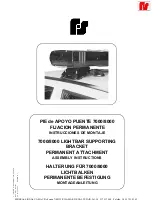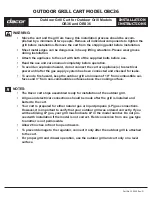
7
Setting Height–of–Cut
Important
To insure proper setting of height-of-cut,
these procedures must be followed in this order:
A. Adjusting (Parallel) Bedknife To Reel
B. Setting Cutting Unit Attitude
C. Leveling Front Roller
D. Adjusting The Height Of Cut
E. Adjusting Turf Compensation Kit
Important
Each cutting unit must be set consistently.
Minor differences in either height-of-cut, attitude,
bedknife wear, or reel blade wear, among cutting units,
may result in negative after cut appearance.
Note: The cutting unit has been set at the factory at 1/2”
(13 mm) height-of-cut and the front roller set in the
normal attitude position (middle hole in front brackets).
Also, the bedknife has been backed off from the reel to
prevent shipping damage.
A. Adjusting (Parallel) Bedknife
to Reel
Important
The reel and bedknife must be parallel to
insure the cutting unit cuts grass across the bedknife, and
the reel and bedknife wear evenly.
1. Rotate cutting unit backward to gain access to the reel
and bedknife (Fig. 6).
1
2
Figure 5
1.
Bottom bedknife adjusting
screw
2.
Top bedknife adjusting
screw
2. Adjustment of bedknife to reel is accomplished by
first, loosening bottom screw on each side of cutting
unit (Fig. 5), then tightening the top adjustment screw
on each side of cutting unit. This adjustment will
position the bedknife closer to the reel blades. Adjust
until light contact is heard on both ends of the reels.
Note: Correct reel to bedknife contact should not increase
the reel rolling torque more than 3 in–lbs. over the reel
bearing rolling torque setting (see Servicing and
Adjusting the reel bearings for checking reel rolling
torque).
Figure 6
Important
Use only a 3/8 open end wrench 3” to 6”
(76–152 mm) in length for adjusting bedknife to reel. A
longer wrench will provide too much leverage and may
cause distortion of the mounting plate for the adjustment
screw.
3. After adjusting bedknife to reel, make sure that both
the top and the bottom adjustment screws are secured
on both ends of the cutting unit (Fig. 5).
4. Insert 1” (25 mm) wide piece of newspaper
perpendicular to the bedknife, and then rotate the reel
slowly in the mowing direction to see if the reel cuts
the paper – do this on both ends of the bedknife
(Fig. 6).
5. If paper is cut on both ends, the bedknife is parallel to
the reel. If not, go back to step 2.
Note: If reel makes contact on both sides of bedknife but
still does not cut paper, cutting unit may need to be
backlapped (refer to backlapping) or reel and/or bedknife
may need to be reground (refer to Toro manual for
Sharpening Reel and rotary Mowers, Form No.
80–300PT).
Summary of Contents for 03527
Page 15: ...15...


































